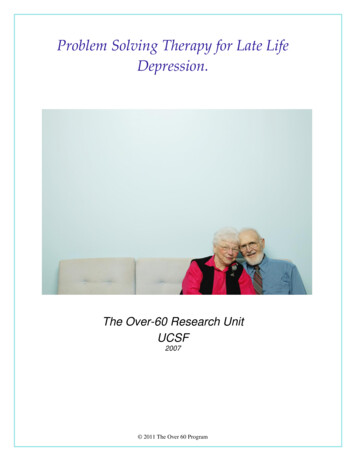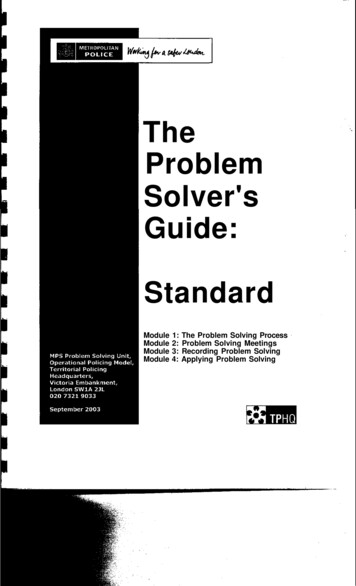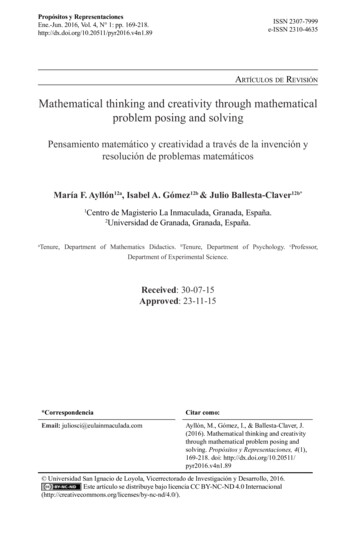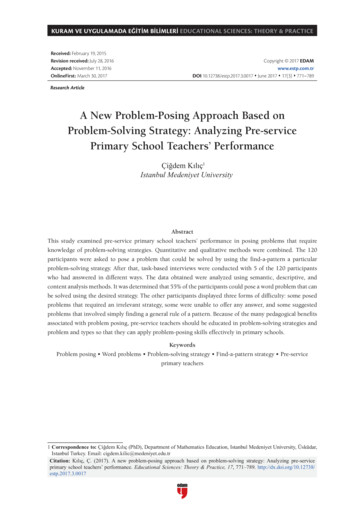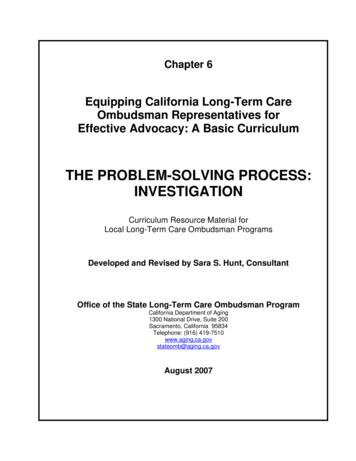
Transcription
Chapter 6Equipping California Long-Term CareOmbudsman Representatives forEffective Advocacy: A Basic CurriculumTHE PROBLEM-SOLVING PROCESS:INVESTIGATIONCurriculum Resource Material forLocal Long-Term Care Ombudsman ProgramsDeveloped and Revised by Sara S. Hunt, ConsultantOffice of the State Long-Term Care Ombudsman ProgramCalifornia Department of Aging1300 National Drive, Suite 200Sacramento, California 95834Telephone: (916) t 2007
InvestigationTABLE OF CONTENTSI.INTRODUCTION. 3II.OMBUDSMAN APPROACH TO PROBLEM SOLVING . 3Uniqueness of the Ombudsman Approach . 4Common Problems . 4Barriers to Self-Advocacy . 5Role of the Ombudsman/Advocate . 6III. POLICY CONSIDERATIONS . 8Documentation. 8Confidentiality . 8Encouraging Self-Advocacy. 9IV. DILEMNAS IN RECEIVING COMPLAINTS . 9V.USING THE THREE STAGES OF PROBLEM SOLVING . 12VI. STAGE 1: INTAKE, INVESTIGATION AND VERIFICATION. 18Intake: Recognizing and Receiving Complaints. 18Identifying Unvoiced Complaints . 18Sources of Complaints . 18Investigation: Gathering Information . 19Preparation for an Investigation . 20Interviewing . 24Interview Record Checklist. 30Observation. 30Using Official Documents. 33Verifying and Defining the Problem . 44VII. SUMMARY . 46APPENDIX A:THE PROBLEM SOLVING PROCESS: GUIDELINES FOR PRACTICE. 47California Long-Term Care Ombudsman Program2August 2007
InvestigationI.INTRODUCTION1The first function of a Long-Term Care Ombudsman Program (LTCOP) listed in the federalOlder Americans Act is to:Identify, investigate, and resolve complaints that are made by, or on behalf of,residents 2This chapter focuses on the investigation process and skills used by Long-Term CareOmbudsman (LTCO) representatives. Investigation is the foundation of resolving problems.Another chapter, “The Problem-Solving Process: Resolution,” discusses the process andskills LTCO use to implement necessary changes after an investigation.As a LTCO how you approach identifying, investigating, and resolving complaints directlyaffects: your relationship with residents and staff, your ability to achieve the desired outcome, future relationship with residents, families, and staff, and the reputation of the LTCOP.II.OMBUDSMAN APPROACH TO PROBLEM SOLVINGIn an institutional setting, certain practices and methods of operation are developed toensure efficiency. While efficiency is a legitimate business concern, these practices andmethods may conflict with the needs of individual residents. It has been argued that a“good facility” is one that attempts to balance the need for efficiency with quality of lifeissues; a “bad facility” is more likely to focus solely on efficiency.3 Moreover, nursing homesare based on the medical model with its emphasis on health and safety concerns. Theseconcerns sometimes overshadow the right to make choices that involve at least somedegree of risk: an example is the use of restraints.Problem solving or complaint resolution is the primary means that ombudsmanrepresentatives use to ensure that residents’ rights are understood and honored in such anenvironment. It involves educating residents, staff and others about rights, and helping tofind practical solutions to problems that arise when the interests of the facility and theinterests of the individual conflict.Responding to and resolving complaints can be difficult. There will be times when you willbe called upon to support the resident in a decision that may be clearly harmful to him/her.There will also be times when you will be trying to balance the rights of one resident againstthe rights of another. After all, in any communal setting, there will be differences of opinionand preference.1Much of this chapter content is adapted from the Long-Term Care Ombudsman Program Manuals from Louisiana and Alaska,developed by Sara S. Hunt. Alaska manual available on www.ltcombudsman.org2Older Americans Act, § 712(a)(3)(A)(i).3Wayne Nelson, Ph.D., Deputy Director, Oregon Ombudsman Program. “What Kind of Ombudsman Are You?” Speech delivered at the13th Annual Louisiana Ombudsman Conference.California Long-Term Care Ombudsman Program3August 2007
InvestigationWhatever the situation, the process is the same. Complaint handling is really nothing morethan a problem-solving process. It is a systematic, rational process you follow—from receiptof a complaint through investigation and resolution. As you handle more and morecomplaints, you will adapt this process to your own style. Eventually, it will become secondnature.Uniqueness of the Ombudsman Approach4The LTCO’s goal in problem solving is achieving satisfaction for residents. The approachan ombudsman uses is critical not only to the immediate outcome but also to effectivenessin the future with residents and staff. If residents see ombudsman representatives workingto build relationships, residents are better able to trust LTCO to help them without feelingthat their own relationships with staff will be strained. Therefore, as an ombudsman, youmust carefully select your strategies and be skillful and thoughtful in investigating andresolving problems. This resource chapter is designed to assist you in understanding theprocess and in refining your skills.Real problem solving requires taking the time to understandwhat factors affect how the staff is working, as well as what theresident is experiencing. Since the LTCO’s primary responsibilityis problem solving, you can take the time to get to know theresident’s situation in depth and to look into creative solutionsthat are workable for the staff and residents. A solution will work only if it is based onmutual understanding and if it works for all parties.Theombudsman’smain responsibility isproblem solving.Ombudsman representatives seek to work in such a way that staff understand more ofwhat is at the heart of a resident’s concerns and find ways to respond to the resident’sneeds. As a result, ombudsman representatives hope to see a difference inthe way care is provided for an individual in both observable aspects andattitudinal aspects. Working on behalf of one resident can lead tochanges in facility policies and routine practices. Thus, all residentsbenefit.The ultimate goal of the ombudsman approach to problem solving is tohelp staff become more responsive to residents and residents betterequipped to directly express their concerns to staff.Common ProblemsCommon problems likely to surface in facilities include: Loneliness, the need for someone to Inability to live independently coupled withtalk witha desire on resident’s part to leave facility Boredom: not enough social or Use, accounting, and safe-keeping ofpersonal activitiespersonal funds and personal possessions Problem with roommate(s) Limited opportunities to go outside the Lack of privacyfacility for community activities Poor food service or quality Need for assistance to find or purchaseservices Inability to get services, care, or4Adapted from “Ombudsmen as Problem Solvers” by Barbara Frank, in the Training and Resource Manual for Volunteer ResidentAdvocates. Connecticut Nursing Home Ombudsman Program. 1996.California Long-Term Care Ombudsman Program4August 2007
Investigationattention because of physical orcommunication problems Physical or chemical restraints Neglect Transfer from one room to anotherwithout notice Insufficient medical or nursing care Physical or mental abuse Additional or high charges for “extra” Transfer to another facility because of Conservator/Guardianship issues Loss of dignity and self-respect based onchange from private pay to Medicaid Need for assistance to document ormake complaintsservices No rehabilitative caregeneral treatment in facility Need for legal assistance to make will orto make arrangements for disposing ofpersonal funds or possessions, or forother mattersBarriers to Self-AdvocacyResidents may be unable to express their particular needs without assistance from others.Barriers to self-advocacy are manifold. There are at least three kinds of barriers to selfadvocacy, as indicated below. They are psychological/psychosocial barriers, physical andmental barriers, and information barriers.Physical and MentalPsychological/Psychosocial Fear of retaliationSense of isolationLethargyDisorientationLoss of confidenceDepersonalizationDisdain for the label complainerSocial pressure to conformFear of upsetting the familyBelief that this is the best it can beSense of hopelessness and/ordespairInability to question authorityMystique about medical issuesLack of familiarity with staffLack of experience with assertivebehavior, particularly for womenStereotypes, fears about ageSense of weakness resulting fromillnessCalifornia Long-Term Care Ombudsman ProgramHearing lossLoss of speechImmobilityMemory loss or other impairments incognitive functioning Inaccessibility of staff Impaired vision Diminished physical strength Effects of medications DepressionInformation Theresidentlacksinformationconcerning: Rights, entitlements, benefits Authority within the facility Legal and administrative remedies Alternatives How to improve the situation The right to complain and how toadvocate for change5August 2007
InvestigationRole of the Ombudsman/AdvocateAs an ombudsman, you will be an advocate acting on behalf of residents. In some cases,you will be able to educate, support, and encourage residents to engage in self-advocacy,to represent themselves. In other situations, you will be representing the resident. Residentempowerment needs to be a part of your problem solving strategies. There are some basicguidelines to remember in advocacy. These “do’s and don’ts” are listed in Tables 1 and 2.Another important aspect of the role of advocate is personal style, or demeanor, inpresenting problems to staff. An approach that is hostile, aggressive (rather than assertive)or blaming will cause great damage to your working relationship and make it difficult for youto collaborate with the facility staff in solving problems. On the other hand, a style that is toopassive will not be effective in ensuring that the resident’s rights are respected.As an advocate, you are called upon to be respectful, and sometimes even empathetic, tothe concerns of the facility. Yet you must also be persistent and professional in your pursuitof the implementation of a resident’s rights. You can serve the resident’s interests best ifyour manner is “firm, fair, and friendly.”5 5Table 1. The Do’s of AdvocacyRespect the confidentiality of allcomplaints made to you.Be a good listener.Assure the resident that you arethere to listen to his/her problem.Speak clearly and slowly so thatthe resident can understand you.Talk to the resident in a quiet,private area.Explain things in a few words,rather than in long paragraphs,acronyms and jargon.Be objective, yet understanding.Give an accurate picture to theresident of what he/she canexpect.Convey a sense of care and adesire to help to the resident.Remember that some residentsmaydistortorexaggerate;therefore, an accurate and reliableassessment of the problem isnecessary.Work with the resident, the staff,and the administration in solving Table 2. The Don’t’s of AdvocacyDo not provide physical or nursingcare. This is the responsibility of thestaff working in the facility and is forthe resident’s protection as well asthe advocate’s.Do not bring unauthorized articles intothe home such as food, drugs,prescriptions,tobacco,alcoholicbeverages, or matches.Never treat the residents as children.They have a lifetime of experience.Do not diagnose or prescribe for aresident.Do not make promises that may beimpossible to keep.Do not advise residents on businessor legal matters; refer them toappropriate professionals.Do not be critical of the residents orthe facility.Do not engage in arguments, butrather, stick to the question orproblem at hand.Do not forget that you are not aninspector of the facility. You are thereWayne Nelson, Ph.D., Deputy Director, Oregon Ombudsman Program. “What Kind of Ombudsman Are You?” Speech delivered at the13th Annual Louisiana Ombudsman Conference.California Long-Term Care Ombudsman Program6August 2007
Investigation Table 1. The Do’s of Advocacyproblems.Remember that it may take somequestions and perseverance to getto the real problem.Make an effort to understand thetotal situation or problem byseeking out as many sources ofinformation as possible.Remember that the resident maytire easily, have a short attentionspan,digressduringconversations, or simply becomeconfused.Keepaccuraterecordsasrequested for the program.California Long-Term Care Ombudsman ProgramTable 2. The Don’t’s of Advocacyto listen to individual complaints andtry to resolve them.7August 2007
InvestigationIII. POLICY CONSIDERATIONSDocumentationDocumentation is extremely important for accurate reporting and for allowing others whomay later become involved in a complaint to know what steps you’ve already taken.Furthermore, any complaint may at some time become a source of litigation, and cleardocumentation will be critical.Some ombudsman representatives find keeping a diary or journal of their visits helpful. Thisallows them to remember personal information about residents, observations of potentialproblems, and events that may not seem significant at the time, but turn out to be importantlater. It may also make it easier to complete the forms your local LTCOP requires forreporting your activities to the State Long-Term Care Ombudsman Program (SLTCOP). Besure that whatever type of documentation you keep is consistent with the policies of yourlocal LTCOP.ConfidentialityAll records and information obtained during an investigation or during the resolutionprocess must be held in confidence. Information may only be disclosed if the complainantor resident or his/her legal representative consents to the release of the information or bycourt order. The federal law concerning confidentiality and disclosure can be found in theOlder Americans Act [42USC3058g (d)(2)].Explain the confidentiality policy to the complainant at the outset of the complaint-handlingprocess. Unless explicitly given approval to reveal someone’s name, you must keep thename and identity of a resident or complainant confidential. In cases where theresident/complainant agree to reveal their identity, a signed consent form documenting thatpermission was given and stating who will be told their identity is required. Check with yourlocal LTCOP Coordinator for copies of these forms.Permission to disclose the identity also applies to asking complainants other than theresident for permission to tell the resident that they contacted you. You need to ask, “Is itokay to tell Mrs. Jones that you contacted me about this problem?” You will usually be told“Yes.” The section on ethical dilemmas offers guidance on how to proceed if you are told“No.”Sometimes people will make a complaint only under the condition of anonymity. If anindividual insists on having his/her name kept secret, explain that, while you will doeverything possible to protect their identity, there is the possibility that the facility may beable to determine who made a complaint. Explain that some complaints are virtuallyimpossible to investigate without revealing the identity of the resident. For example, acomplaint regarding a resident’s finances may not be adequately checked unless financialrecords are reviewed, which would immediately indicate who had filed a complaint.If the use of a complainant’s name is initially denied but is needed to proceed further with acomplaint investigation, talk with the person again to: explain the situation,California Long-Term Care Ombudsman Program8August 2007
Investigation request to use the complainant’s name, and discuss any potential risks involved in the complainant’s being identified.See Table 3 for additional guidance on this issue.A guarantee that retaliation will not occur should never be offered toobtain the complainant’s permission to use his/her name.Encouraging Self-AdvocacyYou should encourage the complainant to act on his/her own behalf. This is especially trueif the complainant is the resident. Offer information, support, and guidance, but encouragethe complainant to take action to resolve the problem. Sometimes a complainant may bewilling to participate in the problem-solving process if you can join them in any meetings tooffer assistance. A more complete discussion of encouraging self-advocacy,empowerment, can be found in the chapter, “Residents’ Rights.” If the complainant is notthe resident, it may be necessary to ask the complainant if they have determined what theresident wants in the matter.If the resident prefers that you act on their behalf, remember that you can do no more thanwhat the resident gives you approval to do. You must also report back to the resident onyour progress.Sometimes a resident will insist that nothing be said or done. In such cases, you have nochoice but to continue to check back with the resident to see if he or she wishes to proceedat a later date.Alternatively, you might find other residents with the same issue who are willing to pursue itto resolution. By resolving the issue for others, you might be able to resolve it for theresident who does not want you to proceed on her behalf.IV. DILEMMAS IN RECEIVING COMPLAINTSYou will inevitably find yourself in a number of complaint situations that pose ethicaldilemmas or call for special handling. The key to knowing how to respond to many of thesesituations is to remember that you represent the resident. The Ombudsman Code of Ethicsin the chapter, “History and Role of the Long-Term Care Ombudsman Program,” can behelpful in clarifying your role. Table 3 lists seven typical situations that may occur and givessuggestions for dealing with these dilemmas.Table 3. Typical dilemmas and suggested responses.DilemmaSuggested ResponseA family member complains abouta resident’s care, but the residentsays everything is fine and asksyou not to proceed.Your primary responsibility is to the resident. If pursuing theinvestigation would identify the resident, you must discontinueit unless the resident grants permission to proceed. As analternative, if you feel there is a problem with the care in thefacility, you might be able to pursue a more generalinvestigation, taking care not to do anything that would revealthe resident's identity.California Long-Term Care Ombudsman Program9August 2007
InvestigationThe resident complains, but a This case is more clear-cut: the resident has requestedfamily member urges you “not to assistance, and you should honor that request. Explain to thefamily that you are obligated to assist residents in resolvingrock the boat.”problems.Relatives want you to investigatetheir complaint, but do not wantthe resident to know what you aredoing. (For example: two relativesare involved in a dispute over whois to provide for the resident’sexpenses; or, relatives may fearthat the resident will be upset oralarmed by a problem.)This is a particularly sensitive situation. It may be advisable tohave a general conversation with the resident to ascertainwhether he/she is concerned about the problem mentioned bythe complainant. You will have to judge whether there is aproblem concerning the resident. If the resident is beingvictimized, you are responsible for addressing the problem.You should not become involved, however, in family disputes,which are not affecting the resident’s well being.A resident who is unable to makedecisions for himself/herself, buthas not been legally declaredincapacitated, makes a complaint.Even though the resident may be confused or unable toexpress a decision, you should check into his/her complaint. Itcannot be dismissed as invalid just because it comes fromsomeone who is confused. However the resident’s conditionshould be considered as one factor in determining whetherthe complaint is valid. Consider what you know about theresident and about the facility. Try to understand what theresident is expressing; determine if there is an underlyingmessage or unmet need.A case arises involving a resident In most cases, you work through the guardian. Exceptions tofor whom a guardian has been this rule would be:appointed. The complaint is about the guardian or some action of theguardian. The complaint is about the issue of whether the guardianis needed. The guardianship is a limited one (the resident retains theright to make some decisions).With these types of cases, talk with your LTCO supervisor. Itmay be advisable to seek advice from the LTCOP legalcounsel or from an appropriate legal agency.California Long-Term Care Ombudsman Program10August 2007
InvestigationTable 3, continued DilemmaSuggested ResponseThe interest of one residentruns counter to the well-beingof a group of residents. (Forexample: a resident maycomplain about being deniedthe right to smoke, but otherssay that the resident has almostset the facility on fire bysmoking in non-smoking areas.)In such cases, try to determine the facts and help the partiesarrive at a solution that, as far as possible, protects therights of the individual and the group. Your role is to assist inaddressing the rights of all residents, not upholding oneresident’s rights to the detriment of other residents.A resident will not give youpermission to reveal her identitybut wants your assistance.Discuss the reasons the resident does not want her identityrevealed. If this will limit your ability to resolve the issue,discuss this with the resident and tell her you will do asmuch as possible without revealing her identity.If you cannot resolve the issue without revealing her identity,tell her what you’ve done and why you cannot take the casefurther. If appropriate, encourage the resident to discuss herconcern with the Residents’ Council. Look for supporting evidence during your regular visits. Look for supporting evidence when visiting otherresidents; perhaps several other residents share thesame issue and you can proceed on their behalf. Inform the resident that you will be available to pursuethis issue if she changes her mind. Check back with herregarding this.A complainant, other than aresident, insists on remaininganonymous and will not giveyou any identifying information.As in the case of residents who do not wish their namesused, such persons should not be forced to reveal theiridentity. The complaint, if specific enough, can beinvestigated using these techniques: Look for supporting evidence during your regular visits. Engage in casual conversations to see how residentsfeel about the issue. Review recent complaints/survey reports to see if similarproblems have been noted. If all else fails, file the complaint for future reference incase similar problems arise.California Long-Term Care Ombudsman Program11August 2007
InvestigationV. USING THE THREE STAGES OF PROBLEM SOLVINGThe problem-solving process includes three major stages of action, as indicated in Table 4.The stages are the following: Stage 1, Intake and Investigation; Stage 2, Analysis andPlanning; and Stage 3, Resolution and Follow Up.The first stage is discussed at length in the following narrative. Stage 2 and Stage 3 arediscussed in the chapter, “The Problem Solving Process: Resolution.” The stages aresimply a way of organizing your work as you seek to resolve problems. If you ever wonderwhat to do next, consult Table 4, the narrative discussion of each stage in the chapters,and Guidelines for Practice in the appendix, to check your work and get additional ideas.Table 4. Stages in the problem-solving process.STAGE 1 INTAKE AND INVESTIGATIONReceive theComplaintReceive problems, complaints, concerns.informationfromGather Information Collectobservations, and records.interviews,Verify the Problem Review information gathered. Assess whatseems to be at the root of the problem. Thecomplaint may be only a symptom.STAGE 2 ANALYSIS AND PLANNINGAnalyze theSituationOnce you identify the problem, consider thecauses.ConsiderSolutionsGenerate alternative solutions or approaches.Who should be involved? When? How? Why?Identify ObstaclesAnticipate obstaclesappropriate approach.tohelpselectanSTAGE 3 RESOLUTION AND FOLLOW UPChoose anApproachFrom your list of alternative solutions, choosethe most efficient way to proceed, keeping anyobstacles in mind. Identify alternative strategiesin case you need them.ActProceed with the selected plan, but be preparedto use an alternative.Evaluate Outcome Check back with the persons involved toevaluate the outcomes. Is the problem solved?Is it partially solved? If not, look for newapproaches or information and start again.California Long-Term Care Ombudsman Program12August 2007
InvestigationTo understand how this problem-solving process applies to a LTCO case, take a look at anexample. Use the following case as an individual study exercise to focus on the Intake andInvestigation steps. White space is included for you to jot ideas and questions. If you workthrough each step, reading and understanding the remaining information in this chapter willbe easier. You will be on your way to approaching situations as an ombudsman.Example: Mrs. Bronner’s PurseAs a LTCO you are visiting residents in Peaceful Acres Nursing Facility. When youstop in Mrs. Bronner’s room, she whispers in an angry voice, “My purse is missing!”What are some potential reasons that Mrs. Bronner says her purse is missing? She can’t remember where she put it. Her daughter took it to have the strap repaired. Another resident wandered into the room and picked up the purse. Someone stole it. She never had a purse in Peaceful Acres. The purse is behind the bed where Mrs. Bronner can’t see it. What Mrs. Bronner really wants is the special handkerchief her husband gave her thatshe always kept in her purse. Mrs. Bronner’s purse is in her room but she is remembering a favorite purse she hadmany years ago. She left her purse in the dining room, and it is now in the box of “lost and found” itemsin the facility.Because there are so many possible explanations for Mrs. Bronner’s statement, how wouldyou determine why Mrs. Bronner said her purse is missing? List a few ideas. Make a noteof any questions you have. If these are not answered by the time you finish reading thischapter, ask your Ombudsman Program Coordinator for guidance.Potential Action Steps to Determine Why Mrs. Bronner Says Her Purse is MissingPotential Steps or ActionsCalifornia Long-Term Care Ombudsman ProgramHow Might This Step Help You?13August 2007
InvestigationPotential Steps or ActionsHow Might This Step Help You?My QuestionsAfter making a few notes, look at Tables 5, 6, and 7 on the following pages. These tableslist potential actions that you might take to determine what Mrs. Bronner really means whenshe says her purse is missing.California Long-Term Care Ombudsman Program14August 2007
InvestigationTable 5. Information that could help resolve complaint.Interviewindividuals Mrs. BronnerSeek Information Such as the Following 1. A description of her purse2. What she remembers about the purse,when she last had it, where she keeps itwhen she is not using it, what she doeswith it when she uses it.3. What actions Mrs. Bronner has taken tolocate her purse.4. Is Mrs. Bronner really wanting her purseor is she seeking something else, perhapssomething that she associates with thepurse?5. Does Mrs. Bronner want your help?6. Will she let you use her name if you talkwith anyone else?Mrs.Bronner’s 1. What can she tell you about Mrs.daughter, with Mrs.Bronner’s purse?Bronner’s2. Has she taken any action regarding Mrs.permission.Bronner’s missing purse?3. When did she last see Mrs. Bronner’spurse?4. If she thinks Mrs. Bronner is looking forsomething else, what might it be?5. Has she had any experiences with otheritems missing in Peaceful Acres? If so,how has the facility responded?Other residents with 1. Have they seen Mrs. Bronner with aMrs.Bronner’spurse? If so, when? What does she dopermissionwith her
Investigation California Long-Term Care Ombudsman Program August 2007 6 Role of the Ombudsman/Advocate As an ombudsman, you will be an advocate acting on behalf of residents.


